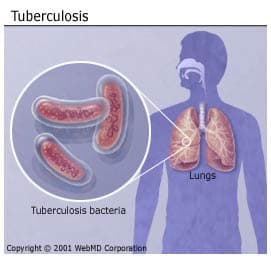Understanding Tuberculosis -- the Basics
In this article
What Is Tuberculosis?
Tuberculosis, commonly known as TB, is a bacterial infection that can spread through the lymph nodes and bloodstream to any organ in your body. It is most often found in the lungs. Most people who are exposed to TB never develop symptoms because the bacteria can live in an inactive form in the body. But if the immune system weakens, such as in people with HIV or elderly adults, TB bacteria can become active. In their active state, TB bacteria cause death of tissue in the organs they infect. Active TB disease can be fatal if left untreated.

Because the bacteria that cause tuberculosis are transmitted through the air, the disease can be contagious. Infection is most likely to occur if you are exposed to someone with TB on a day-to-day basis, such as by living or working in close quarters with someone who has the active disease. Even then, because the bacteria generally stay latent (inactive) after they invade the body, only a small number of people infected with TB will ever have the active disease. The remaining will have what's called latent TB infection -- they show no signs of infection and won't be able to spread the disease to others, unless their disease becomes active.
Because these latent infections can eventually become active, even people without symptoms should receive medical treatment.Medication can help get rid of the inactive bacteria before they become active.
TB was once a widespread disease. It was virtually wiped out with the help of antibiotics developed in the 1950s, but the disease has resurfaced in potent new forms -- multidrug-resistant TB and extensively drug-resistant TB. Today, these new and dangerous forms of the disease -- resistant to some of the commonly used drug treatments -- have created a public health crisis in many large cities worldwide. If you have TB -- in its active or latent state -- you must seek medical treatment.







0 comments:
Post a Comment